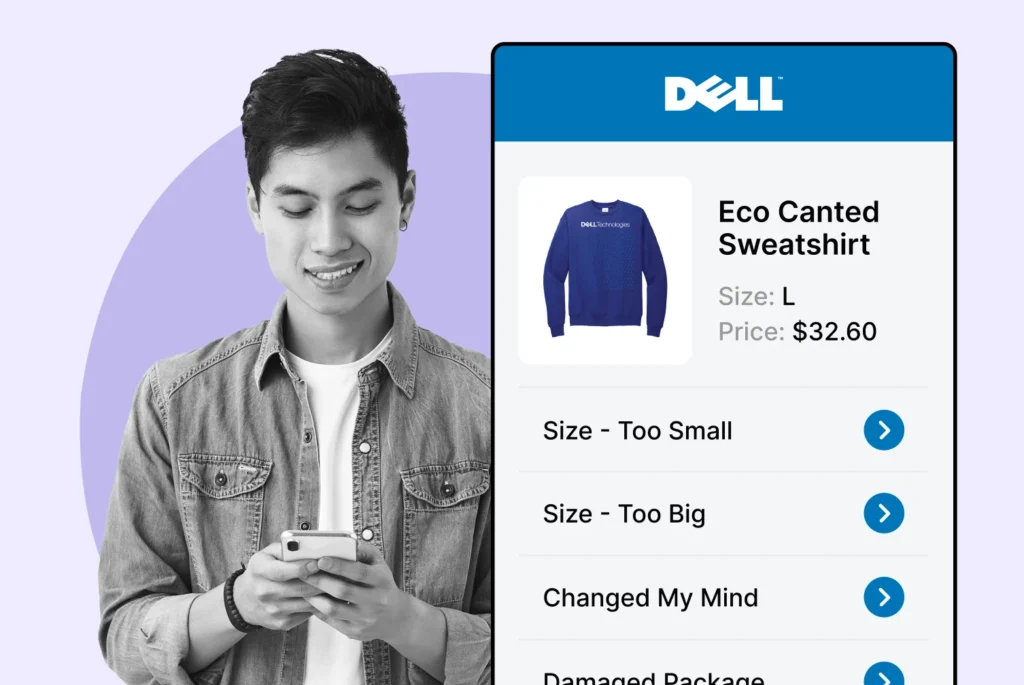
10 Compelling Reasons New eCommerce Stores Need a Returns Portal
From enhancing user experience to trimming operational costs, here’s a rundown of ten hard-hitting “reasons to have a returns portal”.
Boost customer experience and reduce support tickets
Realtime order and shipment tracking
Proactive order and shipping notifications
Predictive pre-purchase estimated delivery dates
Self-Serivce branded order tracking
Effortless experience delivered
Make returns profitable and delight customers
Flexibility to define any return destinations & conditions
Simplify returns for your customers and team
Incentivize exchanges over returns
Returns management made easy for your team
Understand why your customers are returning
Unify the online and the in-store experience
Hassle-free pickup experience for customers
In-Store Dashboard to keep operations streamlined
In-Store and Online orders unified
Drive foot-traffic to your stores
Boost customer experience and reduce support tickets
Realtime order and shipment tracking
Proactive order and shipping notifications
Predictive pre-purchase estimated delivery dates
Self-Serivce branded order tracking
Effortless experience delivered
Make returns profitable and delight customers
Flexibility to define any return destinations & conditions
Simplify returns for your customers and team
Incentivize exchanges over returns
Returns management made easy for your team
Understand why your customers are returning
Unify the online and the in-store experience
Hassle-free pickup experience for customers
In-Store Dashboard to keep operations streamlined
In-Store and Online orders unified
Drive foot-traffic to your stores
Find the answer to all your questions
Explore the most comon questions about WeSupply
Calculate the ROI that WeSupply can bring you
Request a no strings attached review of your current shopping experience and missed conversion opportunities
Take a step by step trip through our functionality to see how we can improve your ecommerce processes.
Read actionable articles on how to optimize your post-purchase experience and decrease support tickets
Get inspired by stories of how our customers implemented an effortless post-purchase experience
A Deep Dive into Top Companies' Order Tracking & Returns Strategy
Wondering if WeSupply is a good fit for you? Read through our use cases to see how we can help you increase conversion & improve CX!

Struggling with eCommerce returns? Our essential returns management tips for success will help you create a seamless experience for your customers and reduce return-related costs. Expect to learn how to turn the hassle of returns into a competitive edge, bolstering both customer loyalty and your profit margins. The guide ahead unfolds streamlined, data-informed strategies that are easy to implement and poised to transform your returns process.
Effective returns management in eCommerce is vital for customer satisfaction, reducing operational costs, and maintaining a strong brand reputation, with approximately 30% of all online purchases being returned.
A streamlined returns management process includes clear return policies, efficient reverse logistics, robust customer communication, accurate product descriptions, and the utilization of data analytics to understand and address the causes of returns.
Businesses can enhance the returns experience and sustainability by implementing automation and technology, optimizing packaging and shipping methods, promoting eco-friendly practices, and balancing customer satisfaction with profitability.
WeSupply revolutionizes returns by integrating with major eCommerce and ERP platforms. It automates returns, customizes policies, and reduces workloads with self-service solutions. Key features include automated restocking fees, fraud prevention, customer feedback, and proactive notifications. Optimize returns and boost customer satisfaction with WeSupply. Get started today!
The importance of mastering returns management in eCommerce cannot be overstated. It’s a critical factor in maintaining customer relationships, encouraging future purchases, and ultimately, ensuring the success of your online business.
Now, let’s delve into the world of returns management and discover the strategies that can lead to success.
The returns management process in eCommerce is more than just accepting a returned item and issuing a refund. It’s a comprehensive procedure that begins with a customer’s decision to return a product and includes steps like inspection, offering a refund or exchange, and communication with the customer. Furthermore, managing returns effectively in eCommerce is of utmost importance due to its significant impact on customer satisfaction, increased operational costs, inventory management issues, environmental footprint, and brand reputation.
Interestingly, about 92% of customers are more likely to buy again if the return experience is easy. However, the challenge for businesses lies in creating such a seamless return experience while also managing the financial implications. After all, according to the National Retail Federation, approximately 30% of all products ordered online are returned. This means that businesses need to have robust plans and strategies in place to manage returns effectively and cost-efficiently.
To manage returns effectively, businesses must understand the intricacies of the returns management process. This process involves:
Receiving and processing returns
Inspecting and restocking items
Managing customer expectations and communication
Handling financial transactions
Ensuring compliance with legal and ethical guidelines
From reverse logistics to restocking returned items, each step is critical in ensuring a smooth and efficient returns management process.
Reverse logistics is a key aspect of the returns management process. It involves the movement of goods from customers back to sellers or manufacturers, encompassing processes such as returns, recycling, and disposal of products. But why is reverse logistics so important? Its objectives include reclaiming value from returned products and ensuring customer satisfaction to foster repeat business. By effectively managing reverse logistics, businesses can reduce costs, increase customer satisfaction, and contribute to environmental sustainability.
But reverse logistics is not just about returning the product to the supplier. It includes other components like:
refurbishment, which is the process of restoring returned items to a like-new condition, which may include cleaning, repairing, and testing before resale
returns management
remanufacturing
refurbishment
packaging management
handling unsold goods
dealing with end-of-life products
By understanding and managing these components effectively, businesses can maximize the value recovery from returned products and minimize losses.
WeSupply, a post-purchase software solution, revolutionizes reverse logistics by expertly managing complex return scenarios for eCommerce platforms and ERP systems. Here’s how WeSupply can help:
Integrates with Shopify, Magento, BigCommerce.
Seamlessly connects with ERP systems like NetSuite, Kibo, and Aptos.
Automates returns and exchanges.
Provides instant credit and supports QR code returns.
Allows creation of tailored return rules.
Enables custom return windows to meet unique business needs and customer demands.
Ensures seamless connectivity of order and returns data with existing API-driven utilities.
Enhances customer experience and operational efficiency.
Reduces team workloads by allowing customer-initiated returns.
Sends proactive return notifications to cut down on support tickets.
Profitability and Data Centralization:
Transforms potential return losses into profitable exchanges through online store credits.
Centralizes all order and return data, leading to significant time savings.
Promotes data-driven decision-making for businesses.
Experience the transformative power of WeSupply’s comprehensive return management solutions. Streamline your reverse logistics, enhance customer satisfaction, and boost operational efficiency effortlessly. Book a demo today and discover how we can revolutionize your returns process!
Another important aspect of the returns management process is the collection, inspection, and restocking of returned items. The process includes:
Establishing a clear and accessible returns policy for customers.
Collecting returned items from customers.
Inspecting the returned items for damages or defects and comparing them to the return reason provided.
Restocking the inspected items in good condition to the shelves for resale.
Sending products deemed unfit for resale for refurbishment or disposal.
Efficient reverse logistics processes, such as improving repackage methods and expanding drop-off locations, can streamline the handling of returned items. This not only preserves the resale value of the products but also makes it easier for customers to return items and quicker for businesses to restock them.
WeSupply significantly enhances the process of collecting, inspecting, and restocking returned items, streamlining the entire returns workflow. Here’s how WeSupply can help:
Streamline the Returns Process:
Automatically calculate product-specific restocking fees.
Apply vendor-specific return policies.
Prevent return fraud by identifying and stopping abusers immediately.
Eliminate the need for back-and-forth customer emails and reduce the number of clicks required to handle a return from request to refund.
Collect Product Images and Feedback:
Allow shoppers to upload images of the products they wish to return on a branded returns page.
Enable customers to describe their issues, collecting valuable information that would otherwise require multiple emails.
Inspect Returns and Manage Inventory Better:
Implement defined quality criteria for careful inspection of returned products.
Collect images and feedback from customers to assist in quality control.
Allow warehouse staff to leave notes on each return about the quality of the inspection.
Direct returned items to recycling centers, ensuring returns contribute positively to the environment.
Clear and effective communication is crucial in managing returns. It helps manage customer expectations and builds trust, leading to increased customer loyalty.
Let’s delve deeper into how businesses can enhance customer communication throughout the returns process.
Clear and transparent return policies are key to managing customer expectations and reducing confusion. These policies should be easily understood by customers and guide them on how to request returns, including time limits for returns and guidelines for packaging. The details of a return policy should include the process for making returns, the conditions for acceptance, and any associated costs or fees. By making these policies clear and easily accessible, businesses can build trust and ensure consistency in operations.
However, crafting a clear and transparent return policy is just the first step. Consistently communicating the return policy across various platforms such as the website, customer service, and emails is also crucial for building customer trust. It’s also beneficial for merchants to seek and incorporate customer feedback regarding the returns process to improve their return policies.
WeSupply empowers businesses to communicate clear and transparent return policies, enhancing customer trust and satisfaction. Here’s how WeSupply can help:
Create Custom Return Policies:
Define how to handle final sale items.
Set return window lengths.
Manage return request approvals.
Track and measure key metrics such as Customer Satisfaction (CSAT) and Net Promoter Score (NPS).
Use data-driven insights to improve the post-purchase customer experience.
Identify issues in the return process and optimize for better performance.
Beyond just communicating return policies, businesses must also invest in building trust through effective communication practices. This includes providing excellent customer service during the return process, which can convert potential negative experiences into positive ones, thus increasing customer loyalty. Moreover, using clear and simple language in return policies can avoid legal jargon that may deter customers from making purchases.
Automating the return process can also enhance customer communication. By automating tasks like generating return shipping labels and sending tracking updates, businesses can provide proactive and effective communication, thus streamlining the return experience for customers. Trust in leadership is also crucial for building a culture of trust within an organization, and this can be achieved through regular evaluation of communication practices and the trust they have built with employees.
Building trust with customers can be challenging without effective communication practices, especially during the return process. WeSupply addresses this issue by providing a seamless and transparent return experience. Here’s how WeSupply can help:
Fully customizable tracking pages.
Email and SMS notifications that match your brand for a cohesive, omnichannel experience.
Automate the return process to save 80% of the time spent on returns.
Streamline the entire return process.
Reduce returns fraud and human error.
Collect images and feedback from customers.
Autogenerated QR Code Return Labels:
Make returns easier for customers by enabling QR code scanning from emails, eliminating the need for printing.
Allow customers to track the progress of their returned products and check the status easily.
Proactive Post-Purchase Notifications:
Send return shipping notifications with an open rate as high as 98%.
Provide custom and personalized offers via post-purchase emails and SMS to keep customers engaged.
Enhance your customer experience and build lasting trust with WeSupply’s comprehensive return management solutions. Transform your return process and boost customer loyalty effortlessly. Start your free trial now and see the difference WeSupply can make for your business!
Keep your customers engaged during the delivery experience
Book a quick call with our experts to see how WeSupply can help you engage your customers with relevant updates through the right channel, at the right time.
Accurate product information and descriptions play a crucial role in reducing returns and improving customer satisfaction. By enhancing product descriptions, businesses can provide customers with a clear understanding of what they are ordering, thereby reducing return rates.
Effective product descriptions play a key role in conveying the value of a product and helping shoppers understand why it fits their needs. Detailed product descriptions enhance customer confidence in their purchasing decisions, leading to better conversion rates. Furthermore, providing accurate product information can decrease the likelihood of returns by aligning customer expectations with the actual product.
Creating detailed and accurate product descriptions can be a daunting task, but it’s well worth the effort. Contextual product descriptions that address specific user needs and preferences, complemented by high-quality images, can lead to a more informed purchase decision. After all, a significant 87% of online shoppers consider detailed product descriptions to be essential when making a purchase.
While accurate product descriptions are crucial, they are only part of the solution. Businesses also need to make efforts to better understand their customers to reduce returns. By using a Product Information Management (PIM) system, businesses can offer personalized product experiences and intelligent recommendations, which help in reducing returns and increasing customer lifetime value. Furthermore, detailed product descriptions that include the product’s purpose, benefits, and functionality can help customers make more informed decisions, thereby reducing the likelihood of returns.
Other strategies for reducing returns include providing multiple product images and videos to improve customer understanding of products and reduce the likelihood of returns. Additionally, dynamic sizing charts, particularly in apparel, can assist customers in selecting the correct size, reducing the likelihood of returns due to sizing issues.
Inaccurate product information and descriptions can lead to increased returns and customer dissatisfaction. WeSupply addresses this issue by providing detailed returns analytics that help improve product offerings and descriptions. Here’s how WeSupply can help:
Quickly identify return reasons at the product and variant level, including color, quality, and size.
Adjust sizing charts based on specific product feedback.
Review and enhance product images.
Identify products that need more reviews.
Gather customer feedback on product fit.
Streamline Processes and Policies:
Identify the most exchanged products.
Collect valuable product feedback from customers.
Understand the financial impact of returns and exchanges.
Increase Customer Lifetime Value:
Analyze returns by region.
Determine common return reasons to refine product descriptions and improve customer satisfaction.
Streamlining the return process is crucial for customer satisfaction. A smooth and hassle-free customer returns experience can turn a potentially negative situation into a positive one, encouraging repeat business and loyalty.
Simplifying the return process can significantly enhance the customer experience. Establishing a clear and transparent return policy, keeping it visible, and ensuring it is specific about deadlines and conditions can simplify the return process for customers. Proactively updating customers during the return process with tracking and status updates can also enhance the experience and reduce customer anxiety.
Furthermore, streamlining the return process can be achieved by allowing customers to drop off their packages at numerous retail and contactless drop box locations. By making the return process easy for the customer, businesses can increase customer satisfaction and encourage repeat purchases.
Another way to enhance the return process is by providing customers with convenient options for return labels and drop-off points. Some options to consider include:
Pre-paid label returns
Ship with any carrier
Return to store
Additional drop-off locations
Offering multiple return options, including free returns, facilitates convenience for customers.
Supplying pre-paid return shipping labels can simplify label printing for customers and reduce errors related to shipping addresses. By providing customers with easy and convenient return options, businesses can enhance customer satisfaction and make the return process less daunting.
A complicated return process can frustrate customers and decrease satisfaction. WeSupply streamlines the return process, making it easier and more efficient for customers. Here’s how WeSupply can help:
Flexible Return Rules: Create customized return policies to match any use case, ensuring hassle-free returns.
Autogenerated QR Code Return Labels: Simplifies returns by allowing customers to scan a QR code from their email, eliminating the need for printing.
Returns Tracking: Enables customers to track their returned product’s progress and check the status easily.
Buy Online, Return In Store: Offers the convenience of in-store returns for online purchases.
Printerless Returns via QR Code: Enhances the return experience by allowing customers to ship returns without a printer, with drop-off options at eligible locations.
Simplify your return process and enhance customer satisfaction with WeSupply’s innovative solutions. Experience the benefits of a streamlined, customer-friendly return process today.
Data analytics plays a crucial role in returns management. By leveraging data, businesses can identify patterns and frequent issues in returns, thereby enhancing the overall returns management process.
Using data effectively can help businesses identify trends and common issues in returns. Analyzing product return rates allows companies to understand how frequently customers return products and the reasons behind these returns. This information can be crucial in shaping return policies and improving customer service.
Consistent methodologies in data analysis, aided by AI-driven analytics, can provide objective and real-time insights, enabling quicker identification of trends and root causes of product returns. By using data to identify patterns and frequent issues, businesses can address problems proactively and improve their operations.
Customer feedback is an invaluable resource for businesses. It allows them to continuously enhance the returns process and address areas of concern. For instance, customer feedback is invaluable for shaping customer experience and can be categorized into direct feedback, like surveys and focus groups, and indirect feedback, such as social media activity and online reviews.
Strategically timed surveys after specific customer touchpoints can gain insights on particular aspects of the customer experience, such as the delivery or returns process. Moreover, incorporating omnichannel feedback methods allows businesses to collect more comprehensive feedback from customers across various platforms without requiring them to switch communication channels. By monitoring and responding to customer feedback, businesses can continuously improve their returns process and enhance customer satisfaction.
Inaccurate understanding of return patterns can hinder improvements in product offerings and customer satisfaction. WeSupply addresses this issue by leveraging data analytics for returns management, providing actionable insights that help refine your processes. Here’s how WeSupply can help:
Identify the most returned products.
Understand the reasons behind product returns.
Detect customers who are serial returners.
Reduce return rates with actionable insights.
Access returns data in BigQuery for detailed analysis.
Returns Analytics for eCommerce Business
Understand why your customers are returning: Identify the most returned products, Understand why those products are returned, Identify which customers are serial returners, Reduce Return Rate with Actionable Insights, Returns data available in BigQuery.
Track Customer Satisfaction (CSAT) and Net Promoter Score (NPS).
Measure and analyze key logistics metrics.
Use data-driven insights to fine-tune and adapt your processes.
With WeSupply, transform your returns management into a strategic advantage, enhancing both operational efficiency and customer satisfaction.
Optimal packaging and shipping methods are crucial in reducing product damages and enhancing efficiency in the returns management process. Businesses must implement effective packaging techniques and enhance their shipping methods to achieve these goals.
Implementing effective packaging techniques is a key strategy for minimizing product damages. Effective packaging requires an understanding of the factors that lead to damage, such as:
environmental conditions
distance
time
compression
vibration
impact throughout the supply chain
Choosing the right packaging material, such as corrugated fiberboard or composite units, is crucial in preventing damage during shipping and handling.
Furthermore, stress-testing packaging can reveal how well it will hold up under various conditions, ensuring the protection of products during transit. By implementing effective packaging techniques, businesses can reduce product damages, decrease return rates, and enhance customer satisfaction.
Enhancing shipping methods can improve efficiency, safety, and customer satisfaction in the returns process. Optimizing space efficiency and reducing unused space in packaging can decrease shipping costs and minimize the risk of damage during transit. Additionally, optimizing route planning through software or algorithms can reduce travel time and minimize fuel costs, contributing to improved shipping efficiency.
Leveraging real-time tracking technologies like GPS or RFID provides visibility of shipments to both customers and internal stakeholders, helping improve shipping efficiency. By enhancing shipping methods, businesses can reduce damages, improve efficiency, and enhance the overall customer experience in the returns process.
Automation and technology can play a crucial role in creating a streamlined returns management process. They can improve efficiency, reduce costs, and enhance customer satisfaction.
Automating return request processing and documentation can significantly enhance the returns management process. Automation in return request processing allows for:
The generation of return labels
Tracking of returns
Automated approval or rejection of return requests
Issuing of refunds or store credits
Creating a self-service portal for returns integrated with the order management system can automate the generation of prepaid return shipping labels, streamline return request processing, and facilitate issuing store credit when applicable.
Automated systems facilitate the validation of returns by checking eligibility, ensuring compliance with return policies, and verifying details such as condition and warranty coverage. By automating return request processing and documentation, businesses can reduce manual errors, save time, and enhance the overall returns management process.
Advanced technological solutions can help streamline operations in returns management. Real-Time Inventory Management Software updates inventory data continuously to promptly identify stock availability, thus reducing the time between receiving a return and making the product ready for resale. A centralized inventory control and shipping visibility through RMS provides greater control over returned inventory, enabling efficient processing and tracking of returns.
In addition, Warehouse Management Systems (WMS) are used to provide a comprehensive platform for managing inventory, order fulfillment, and returns. These systems enable seamless tracking of returned items and optimize their movement through the warehouse. By leveraging advanced technological solutions, businesses can streamline their operations, improve efficiency, and enhance customer satisfaction.
Manually managing returns can be time-consuming and prone to errors, leading to inefficiencies and customer dissatisfaction. WeSupply addresses this issue by implementing automation and technology to streamline the returns process. Here’s how WeSupply can help:
Enable self-service returns for customers to return items anytime without needing support tickets or calls.
Streamline the Returns Process:
Automatically calculate product-specific restocking fees.
Apply vendor-specific return policies.
Prevent return fraud by identifying and stopping abusers immediately.
Eliminate the need for back-and-forth customer emails and reduce the number of clicks required to handle a return.
Identify and mitigate fraudulent return activities.
Automate calculations and validations to minimize user errors in restocking fees and returnable products.
Avoid mistakes, save time, and save money through automation.
Facilitate exchanges, reshipments, and warranties efficiently.
Inspect Returns and Manage Inventory Better:
Implement quality control measures for returned products.
Collect images and feedback from customers.
Allow warehouse staff to leave notes on the quality of each return inspection.
By leveraging WeSupply’s automation and technology, businesses can enhance efficiency, reduce errors, and improve customer satisfaction in their returns process.
With a growing emphasis on sustainability, businesses must also consider how to make their returns practices more eco-friendly. Reducing the environmental impact of returns is not only good for the planet but can also enhance a company’s brand reputation and customer loyalty.
Implementing eco-friendly practices in returns is a crucial aspect of sustainable returns management. Some eco-friendly practices to consider include:
Using recyclable papers and cardboard for packaging materials
Utilizing plant-based bioplastics and biodegradable plastics
Using plant fibers like jute and cotton for packaging
Introducing features like ‘Green Returns,’ which allow customers to keep the item and avoid return shipping, thus reducing landfill waste and emissions.
These practices can help minimize environmental impact in returns and contribute to a more sustainable approach.
Notably, paid returns policies can lead to a decrease in the volume of returns, thus reducing transportation, emissions, and waste, and encourage more responsible consumer behavior. By implementing eco-friendly practices in returns, businesses can reduce their environmental impact while also enhancing customer satisfaction.
Balancing sustainability with operational efficiency is a major challenge for many businesses. Returns management systems with analytics capabilities are enabling companies to decrease return rates, thus balancing sustainability with operational efficiency. Furthermore, the strategic shift towards paid returns is aimed at improving cost management, operational efficiency, and environmental sustainability, while also enhancing the customer experience by encouraging more considered purchasing decisions.
Transparent communication and education about paid returns benefits can help e-commerce businesses maintain customer satisfaction while implementing a cost-effective returns strategy. By balancing sustainability with operational efficiency, businesses can ensure profitability while also maintaining a commitment to environmental responsibility.
Uncertainty and inefficiencies in the returns process can lead to unnecessary waste and environmental impact. WeSupply promotes sustainable returns practices by providing clear guidelines and eco-friendly solutions. Here’s how WeSupply can help:
Green Returns: Allow customers to keep low-cost items when requesting a return, saving on shipping costs and preventing items from ending up in landfills.
Generate Return Labels Automatically: Enable customers to easily generate return labels automatically, even if staff is unavailable.
Printerless Returns via QR Code: Improve customer experience by allowing them to ship returns without a printer, using a QR code instead of a PDF.
Return In-Store or via Curbside: Offer convenient in-store or curbside returns, similar to drive-through services.
Intelligent Dispositions: Direct returned items to recycling centers, ensuring returns contribute positively to the environment.
By leveraging WeSupply’s solutions, businesses can enhance sustainability in their returns process, reducing waste and improving customer satisfaction.
Balancing customer satisfaction and business objectives is a key challenge in returns management. Businesses must manage customer expectations with their capabilities and implement strategies that ensure profitability while also enhancing customer satisfaction.
Managing customer expectations with business capabilities is crucial in balancing customer satisfaction and business objectives. Retailers need to recognize that a significant number of returns occur due to errors on the part of the retailer, such as sending the incorrect item, products differing significantly from their description, or items arriving damaged. By setting up clear guidelines on how to complete returns and exchanges, businesses can manage customer expectations and align with their capabilities.
Furthermore, by staying aware of the common reasons for returns, businesses can better shape their return policies to manage customer expectations effectively. Some common reasons for returns include:
Wrong size or fit
Defective or damaged product
Changed mind or no longer wanted
Received the wrong item
Poor quality or not as described
A strong customer satisfaction approach is generally prioritized over short-term profitability, as it is less costly to retain existing customers than to attract new ones.
Implementing strategies that ensure both customer satisfaction and profitability is crucial in returns management. Regularly reviewing and adapting return policies based on customer feedback and industry trends can help maintain healthy profit margins. Furthermore, a smooth return process with clear instructions and communication can transform a dissatisfied customer into a loyal one.
Balancing customer satisfaction with profitability and ROI can be challenging for businesses. WeSupply addresses this issue by implementing strategies that streamline returns, reduce costs, and enhance customer experience. By automating the return process, offering flexible return policies, and providing detailed returns analytics, WeSupply ensures that your business maximizes profitability while keeping customers happy. Use our ROI Calculator to discover how WeSupply can boost your returns management efficiency and profitability!
In conclusion, successful returns management in eCommerce is a comprehensive process that requires careful planning and effective strategies. From understanding the intricacies of the returns management process to leveraging data analytics and implementing automation, businesses can significantly improve their returns management processes.
By focusing on enhancing customer communication, providing accurate product information, and promoting sustainable returns practices, businesses can not only reduce return rates but also enhance customer satisfaction and loyalty.
To sum up, efficient returns management is crucial for the success of any eCommerce business. It not only helps maintain customer satisfaction but also ensures profitability. By implementing the strategies discussed in this guide, businesses can effectively manage returns, reduce costs, and enhance customer loyalty. Remember, an efficient returns management process is not just about addressing current issues but also about anticipating future challenges and adapting to the evolving eCommerce landscape.
Managing returns efficiently can be challenging for eCommerce businesses, but WeSupply revolutionizes this process with innovative solutions. By integrating with platforms like Shopify, Magento, and BigCommerce, as well as ERP systems like NetSuite, Kibo, and Aptos, WeSupply ensures seamless automation and efficiency. It allows for tailored return rules, custom return windows, and comprehensive self-service solutions that reduce team workloads. Automated calculations of restocking fees, fraud prevention, and customer feedback collection streamline the returns process. Clear, customizable return policies, proactive notifications, and intelligent dispositions enhance transparency and sustainability. Leveraging data analytics, WeSupply identifies return patterns and provides actionable insights to optimize the returns process, minimizing errors and improving customer satisfaction. Get started with WeSupply today!
Efficient returns management is crucial in eCommerce because it greatly influences customer satisfaction and business success. A seamless returns process can lead to increased customer loyalty and repeat business.
Reverse logistics is vital for returns management as it handles the movement of goods from customers back to sellers or manufacturers, reclaiming value from returned products and ensuring customer satisfaction.
Businesses can enhance customer communication in the returns process by implementing clear return policies and building trust through effective communication. This can lead to increased customer loyalty and positive experiences.
Yes, WeSupply allows you to create tailored return rules and custom return windows to meet your unique business needs and customer demands. This flexibility ensures a hassle-free return policy that can handle various scenarios.
WeSupply provides a self-service returns process, allowing customers to initiate returns themselves. It includes features like autogenerated QR code return labels for printerless returns and convenient in-store or curbside return options.
WeSupply promotes sustainability by clearly indicating which goods are returnable, allowing customers to keep low-cost items when requesting a return (green returns), and directing returned items to recycling centers. This approach reduces waste and enhances customer satisfaction.
Yes. WeSupply has an Official Shopify App. You can download it and start integrating with your Shopify Store.
Yes, WeSupply has an official extension for Magento. The WeSupply x Magento integration allows for automating order tracking experiences, reducing customer inquiries, automating shipping email and SMS notifications, and providing a fully branded order tracking experience
Yes, WeSupply has an official BigCommerce App. You can integrate WeSupply with your BigCommerce store to improve your post-purchase customer experience.

Learn How To Create Successful Post Purchase Email Campaigns
Build an effective post-purchase email flow that helps you increase customer satisfaction and drive revenue growth!

From enhancing user experience to trimming operational costs, here’s a rundown of ten hard-hitting “reasons to have a returns portal”.

Get equipped with insights that help you streamline your process and bolster your customer’s trust without any fluff or sales pitches!

Expert tips about returns management that will not only streamline your process but also protect your margins & elevate customer experiences!

Expect to unlock insights on refining your returns process for better customer retention and a healthier bottom line!

Transform your RMA from a logistical challenge into a competitive advantage: actionable strategies to fine-tune your return procedures!

Find out how to handle dropshipping returns effectively to keep your customers satisfied and your operations smooth!

Actionable insights: Perfect your return workflows and bolster customer trust, without getting lost in theory or fluff!

Increase customer satisfaction and profit margins! Actionable steps to manage returns smartly: minimize costs, recover revenue.

In this guide, we dive into optimizing these solutions, with a focus on how Shopify storefronts can particularly benefit.